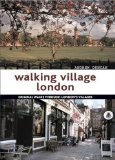London is a huge city encompassing far more than just the historic central area of the West End and the City. Away from the heart of the capital many of the old villages engulfed by the tide of urban expansion have survived to form fascinating and attractive suburbs. In 22 walks Walking Village London explores 25 of the best of them, including Hampstead, Harrow, Chiswick and Kensington north of the Thames, and Dulwich, Wimbledon and Kew south of the river. Each village has its own historical introduction, setting the walk in context, and walk text with full directions and more history and description. Each walk has its own detailed map plus full information on transport, refreshments and opening times. With 35 colour photographs, Walking Village London makes a wonderful treasury of days out for those who want to step off the beaten track and see what London is like beyond the City and the West End.
See the book's contents
North of the River Thames
- Brentford
- Chipping Barnet & Monken Hadley
- Chiswick
- Enfield
- Carshalton
- Hampstead
- Harrow-on-the-Hill
- Highgate
- Isleworth
- Kensington
- Pinner
- Walthamstow
South of the River Thames
- Barnes
- Bexley
- Blackheath
- Carshalton
- Dulwich
- Greenwich
- Ham and Petersham
- Kew
- Mitcham
- Rotherhithe and Bermondsey
- Wimbledon
Read the introduction
Village London? Sounds like a contradiction in terms, but outside its historic centre of City, Southwark, Westminster and West End, London is essentially a collection of villages, gobbled up when the capital expanded on the backs of the railways in the 19th century. Many of these once quiet country villages were completely wiped out by the advancing tide of bricks and mortar. But for various reasons – a powerful preservation society perhaps, or a local shift in the centre of commercial and administrative activity – many also survived. While the surrounding countryside was transformed into a featureless landscape of suburbia, they managed to hang on to their visual identity and historical distinctiveness.
Were London's villages still to be in the traditional rural setting they once enjoyed, many of them would feature in guidebooks, and draw hordes of trippers at weekends in search of a good pub lunch and a stroll in the fresh air. But engulfed in London as they are, their charms are overlooked, their delights ignored and the good things they have to offer are left to the locals to appreciate and enjoy. In a bid to bring their attractions to a wider audience, Walking Village London explores 25 of the best of them – I won't say the best because there is an element of subjectivity in the choice. Six of the villages are paired with neighbours so there are 22 entries in all.
A glance at the map of London villages on pages 12-13 will show that they cover the whole city, north, south, east and west, extending from Kensington and Rotherhithe close to the city centre to Monken Hadley and Carshalton right out on its fringes. The central London villages – hilly Hampstead with its heath and winding lanes and alleys, Chiswick with its beautiful Mall, Kew with its perfectly preserved 18th-century green – are inevitably slightly less unknown than some of the outer London ones. But anyone who makes a trip out to Carshalton with its ponds forming the source of the Wandle, to Pinner with its wonderful High Street and half-timbered farmhouses, to Mitcham with its historic cricket green, to Petersham with its farm where you can buy eggs and honey, and to Bexley with its beautiful riverside mansion – perhaps the most picturesque in all London – is in for a whole succession of wonderful surprises. I have thoroughly enjoyed writing this book, and I hope you get as much pleasure out of reading and using it. 'Using' is the operative word for the only way to see London is on foot. So get out those trainers and hit the trail: you've only got 25 villages and 65.75 miles to go!


'I have read some of your books and I am thrilled! I am going to London for the third time on August 5th, by myself for the first time. You (positively!) drove me crazy with all these walks and I only have two weeks. If you have a minute, please help me and tell me what I should not miss. Thank you so much!'
Pierre from Canada